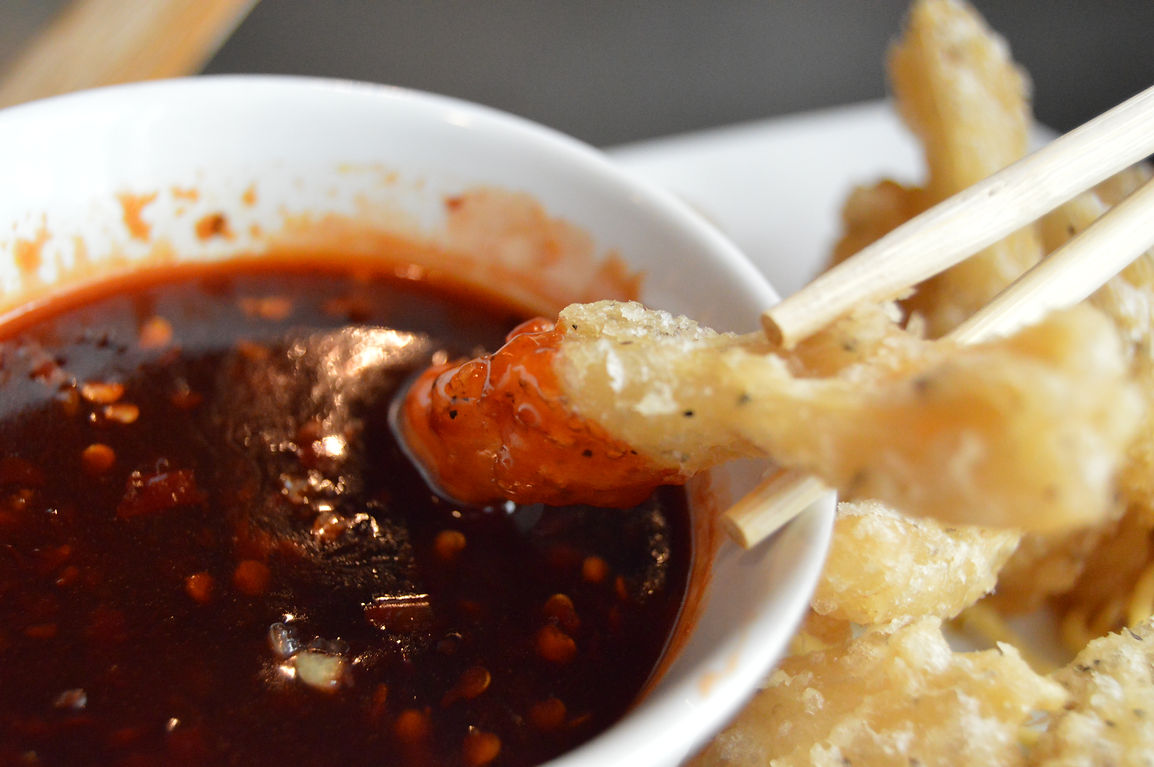
Yan Lin: Bringing a family's culture and warmth to the Chinese restaurant business
Oral History Profile by Sara Holley
In the middle of my interview with Yan Lin, I realized that I was seeing her sit down in her own restaurant for the first time in 16 years.
My family and I have lived in Charlotte, North Carolina, for most of my life. As multiethnic Asian Americans, we prefer restaurants that remind us of Mom’s or Grandma’s home cooking, if only tangentially. Lin’s restaurant, Soho Bistro, which is situated in the heart of Uptown Charlotte, has been our go-to eatery since its opening in 2003. I even celebrated my 18th birthday there.
I was excited to learn about the life of someone whom I had known from a distance for so long.

sitting down for the interview



Wednesday
10 a.m., an hour before lunch
Soho Bistro’s decorations mirror its name, which Lin’s twin sister, Lou, chose because of her fondness of New York City. Ambient lighting fills the room. Cityscape paintings, ornate wall hangings and Chinese good luck charms capture the eye. Room dividers add a cozy, yet elegant touch.
If I recall correctly, Lin hasn’t aged a day in the past decade. Her work uniform ‒ all-black clothes, hair pulled back into a ponytail and glasses ‒ give her a sleek appearance that softens whenever she smiles or laughs.
When she isn’t greeting customers at the front of the restaurant, she’s crunching numbers in the back, directing chefs in the kitchen, or taking customers’ orders.
Since she has the menu memorized, the latter usually turns into a conversation: “How’s school going? Is your mom doing OK? What about dad?” Lin loves this part of her job.
I learned a lot of new information about her during the interview, but it still felt like I was having a conversation with an old friend.
Canton to Charlotte
Where's home?
Lin, 43, was born in Guangzhou, also known as Canton, in the Guangdong province of southern China. A port city northwest of Hong Kong, Guangzhou is home to over 13 million people. She and her family came to the United States when she was 10 years old, so she has spent most of her life there. She now lives in Charlotte, which has a population of about 850,000, with her husband, Lincoln, and her college-aged son, Ethan.
As the daughter of a former restaurant owner, Lin said that co-owning and co-managing her own restaurant with Lou feels like the natural thing to do. Despite all of the tasks she juggles on a daily basis, I have never seen her look frantic. I asked her how living in Charlotte makes her feel.
Her response: “comfortable.”
Guangzhou, China
Credit: PR Newswire

Charlotte, North Carolina
Credit: Nelson Mullins

childhood and early adulthood

MENU
Yan's Childhood Favorites
Dumplings
Vegetables
Duck
Chicken
Seafood
When she was young, her father, Mao, made dumplings at a restaurant in Hong Kong. Her favorite item on the Soho Bistro menu is Peking noodles, which she described as a steamed dish with chicken and sprouts on top.

"My mom used to cook it for us all the time, so that's my favorite entree."
Lin on Peking noodles

Immigrating to the United States
A family reunited
Lin’s immediate family immigrated to the United States in 1985. The whole process took about two years. I asked her why they decided to immigrate.
“Because Grandpa was here,” she explained. “Plus, there was not a lot of opportunity at that time in China. At that time, 1985, not much going on in China.”
The concept of the United States as the land of opportunity was common in China in the the 1980s. The Chinese government had just started to ease pricing restrictions and allow companies to retain profits in the mid-1980s, around the time Lin’s family left. According to the World Economic Forum, the Shanghai stock exchange would not reopen until December 1990, and China would not become a member of the World Trade Organization until December 2001.
Additionally, China and the United States underwent significant policy changes in the late 1970s. China eased its emigration controls in 1978, and U.S.-China relations were normalized in 1979.
Given these economic and political conditions, Chinese immigration to the United States snowballed. The number of mainland Chinese immigrants in the United States nearly doubled from 299,000 in 1980 to 536,000 in 1990. Since 1980, the Chinese American immigrant population has grown more than six-fold.
Hoping to reunite with Lin’s grandfather, her family moved to New York City, where they stayed for about three years.
Fayetteville
When Lin was 13 years old, she moved to Fayetteville, North Carolina, with her sister, younger brother and parents. Her father opened the family’s first restaurant there in 1995.
“Once my dad had the restaurant,” she said, “I could mess around.”
I was surprised by her definition of “messing around.” Lin’s father taught her and Lou how to cook, host, wait tables, etc. The twins eventually began managing the front of the house, while their father managed the back.
Still, Lin is not one to complain. She repeated throughout the interview that she loves what she does.
UNCC
She did, however, take a brief break from restaurant work to earn a bachelor’s degree at the University of North Carolina - Charlotte (UNCC). Her brother also attended UNCC.
“It took me awhile, but I do have a finance degree,” she laughed. “I’m proud of it, too!”
Harrisburg
Lin’s family reunited in 1997, while she was still in college.
“My parents were like, ‘Okay, nobody’s at Fayetteville,’” she explained. “So we sold the restaurant, and everybody came here to Charlotte.”
After relocating, the family opened another restaurant in Harrisburg, North Carolina, a suburban town close to UNCC. Lin worked at the second restaurant for two years before her family sold it.
Charlotte
They opened Soho Bistro a few years later.
Home to Wells Fargo’s East Coast operations and Bank of America’s corporate headquarters, Charlotte has been the second-largest banking center in the United States since 1995. The city’s population increased by almost 200,000 between 2000 and 2010.
Lin’s family used these trends to their advantage when they founded Soho Bistro in 2003. The Harrisburg restaurant served Chinese takeout, but the family wanted a full-scale restaurant downtown. Lin recalled looking for places to open a new restaurant in Charlotte with her father. While driving through Uptown, they found Hearst Tower, which was being built at the time. Hearst is located across from the Bank of America Corporate Center.
Heading South
“I’ve been working in restaurants forever,” she said with a smile. “Nonstop working.”
Lin's youth was defined by two constants: family and the restaurant business.
in the queen city

A Location-Driven Customer Base
Lin spoke to an agent about securing a property right next to Hearst. She added that her background in finance and business law helped her negotiate the lease.
“So we’re here,” she said. “Sixteen years later, still here.”
Soho Bistro’s location is the source of its main customer base, as Lin explained that the “majority is white bankers that come in, and eat, and go back to work.”
I witnessed the tendencies that Lin described when I stayed after the interview for lunch. I typically eat at Soho Bistro during dinner hours, so I was surrounded by a different crowd than usual. In context, the urban theme of the restaurant’s interior design starts to make sense.
“They’re all single, working,” she said. “Most of the time, I don’t have families coming in for lunch. [During] lunchtime, it’s packed here, and you can’t even get in.”
She added that the restaurant is generally better for families during dinner hours, since there are fewer customers and the atmosphere is more mellow. Lin loves having the chance to talk about her family with customers. I remember her telling me that her son had gotten into North Carolina State University about two years ago. She even showed me his senior prom photos.



Browse the following videos to learn about how Soho Bistro's menu was created.

Matters of Personal Taste
Lin always keeps the customers and their palates in mind.
Some dishes are on the menu because they are Lin’s and her sister’s favorites. They serve a lot of noodle dishes because she loves to cook soup at home. But, she does think it is important to cater to the palates of individual customers. Not everyone, for example, can handle spicy Hunanese food.
“Everything is spicy for me,” she said, “but I can’t overkill people here. So everything is a little more mellow. But if you want spicy, then we’ll give you the chili sauce.”
Best-Sellers, and a Note on Authenticity
The best-selling dishes on the menu include Cantonese rice noodles, Hong Kong beef noodle soup, tangerine chicken, and chicken shrimp with mixed vegetables, all of which she described as “more mellow.” She thinks that they are popular because they are not available at nearby Chinese restaurants. Since many of the dishes are specific to Cantonese cuisine, they are harder to find elsewhere.
Lin also noted that a lot of her Asian customers always order the Cantonese rice noodles, Peking noodles, and Hong Kong beef noodle soup.
“Actually, a lot ‒ sorry ‒ a lot of white people have started eating the same thing, too!” she added with a laugh.
Perhaps the trend arose from some Americans’ preoccupation with finding the most “authentic” versions of ethnic food. Lin hears the term often, but she argues that the most authentic meals are made-to-order.
She thinks that the most important consideration in a discussion about authenticity is who you are asking. Soho Bistro’s menu, for example, is her family and her customers’ collective vision.

“Everything’s authentic because you actually make it in the house. Everything’s cooked by the order, so you can adjust.”
Lin on authenticity of food

Home
“Where’s home for you?” I asked.
After a brief pause, Lin replied, “Here, if not New York.”
She traveled back and forth between North Carolina and New York City as a teen. Her parents are among about 570,000 Chinese people who live in New York City. Charlotte’s Asian population is around 48,000. Lin mentioned that Charlotte does not have a large Chinese community, and that the broader Asian community tends to gather in small pockets of the city. However, she still prefers Charlotte because she feels more relaxed there.
“Everybody’s friendly,” she said. “There’s no pushing or shoving everybody.”
Lin clarified that although she enjoys visiting her parents in New York City, she doesn’t love the hustle. She likes that more people in the Charlotte community seem to know each other. She used the same word to describe Cantonese food and Charlotteans: “mellow.”

"Chinese Southerner"
Lin doesn’t mind the mixing of cultures that comes with being a Chinese woman in the South. In fact, she embraces it.
“Actually, someone called me a Chinese Southerner,” she said with a chuckle.
Her favorite part of managing Soho Bistro is talking to customers. She joked that she worries about talking too much. Lin also enjoys the opportunity to share parts of her culture with customers. During Lunar New Year, she tells them about Chinese traditions and passes out mooncakes, which represent family and togetherness.
“I like listening to their life and everything,” Lin said about her customers. “Of course, they learn my life, too.”
She has even seen herself adopting some of her customers’ mannerisms ‒ namely, their accent.

“I’ve lived here for so long that I guess I’ve picked up some accent here or there. I say, ‘Chinese with Southern accent? Awesome.’”
Lin reflects on the "Chinese Southerner" label
what's next?
Lin seems content with what she and her family have accomplished, and she looks forward to retirement.
“Future?” she pondered. “In a couple years, I’m going to sell the restaurant and call it a day.”
Just as I ended the interview, we heard the phone ring. She stood right back up to answer it. Back to work. The lunch rush was about to start, after all. It was the kind of reaction I would expect out of someone who has worked in the restaurant business for 30 years and counting.
Throughout those 30 years, Lin stayed grounded by keeping close to family. She finds happiness in extending her family’s culture and kindness to every customer who walks into Soho Bistro. She identifies Charlotte as home, even though it is more than 8,000 miles away from where she was born. Why?


